
PROGRAM NOTES
Music From Japan: Echoes of the Silk Road
Listen Now
download
Subscribe (itunes)
Subscribe (rss)
help
Program
Music From Japan: Echoes of the Silk Road
February 22, 2012
Fuyuhiko Sasaki, kugo (angular harp)
Mayumi Miyata, sho (mouth organ)
Hitomi Nakamura, hichiriki, o-hichiriki (double-reeds), and voice
Takeshi Sasamoto, haisho (panpipes) and Shoso-in shakuhachi (vertical bamboo flute)
Kyoko Kato, hokyo and percussion
Wonjung Kim, soprano
Sukeyasu Shiba
Kyu Kosomon and Kyukyokushi (1983)
Reconstruction from Shoso-in fragments
kugo, sho, Shoso-in shakuhachi, hichiriki, and hokyo
Winds from Ikaruga (1991)
kugo and sho
Fuyuhiko Sasaki
To Be Human (2012)
kugo, voice, and haisho, based on a poem by Jotaro Wakamatsu
Washington area premiere, commissioned by Music From Japan
Toshi Ichiyanagi
Still Time II (1986)
kugo solo
Akiko Yamane
Dots Collection no. 13 (2012)
kugo and sho
Washington area premiere, commissioned by Music From Japan
Takehito Shimazu
Four Haiku: Four Seasons in Iitate (2012)
Set to a haiku by “madei ambassador” Madoka Mayuzumi
voice, hichiriki, and percussion
Washington area premiere, commissioned by Music From Japan
Maki Ishii
Chronology 1200 (1994)
reigaku (haisho, kugo, and hokyo)
This concert and podcast were made possible through support from the Thaw Charitable Trust. It was presented in conjunction with Silk Road Luxuries from China and as part of the Music From Japan Festival 2012. Audio preservation and editing of this recording were supported by funds from the Smithsonian Women’s Committee.
Listen Now
download
Subscribe (itunes)
Subscribe (rss)
help
Notes
Kyu Kosomon and Kyukyokushi
Sukeyasu Shiba (b. 1935)
Both of these works are reconstructions from fragments of musical notation preserved in the Shoso-in. Kyu Kosomon is a relatively fast piece that depicts a barbarian from the western regions of Asia asking his beloved for her hand, followed by a love duet. Classical gagaku works are structured as Jo (slow introduction), Ha (livelier development), or Kyu (quick-paced climax); this piece corresponds to the last, the Kyu.
Kyukyokushi originally followed the piece Ishu, which brightly paints a picture of the waters of the Yi River flowing south from Luoyang, capital of various Chinese dynasties from ancient times to the late Tang. With its pleasing melodic repetitions, Kyukyokushi evokes an even lighter mood and might be suitable accompaniment for the dances of the apsaras, the female celestial beings that fly through the skies and play musical instruments in the ancient Buddhist Dunhuang cave murals in China.
Winds from Kkaruga
Sukeyasu Shiba (b. 1935)
Perhaps because generations of my ancestors came from that area, I have a great affinity for the landscape of Nara. This piece grew out of my impressions of the village of Ikaruga when I visited it at the young age of thirty. It was early summer, and when I looked out across fields of wheat stretching in every direction, I saw in the distance the white outer walls and five-storied pagoda of a Buddhist temple. And the wind, as it passed over the barley fields, conveyed the sounds of the sho and hichiriki, gradually drawing me into a vision of the ancient world of the eighth century: There is the view of orderly boulevards leading to the capital; people praying at small shrines here and there; villagers holding a festival rejoicing at the successful harvest... And then the sound of the wind brings me back to the world of the present day. Such is the story of this work.
— Sukeyasu Shiba
To Be Human
Fuyuhiko Sasaki (b. 1965)
We’re Homo sapiens. We want to
gather herbs and mushrooms
from the forest. We want
to raise animals, want to plow
the fields, want to plant rice.
We tried to make a living
here in our village.
The hills and forests prepare
their blessings. We will raise
animals again. We will plow the fields
and the rice paddies, and we wish
that we could all return
to live in our village again.
It’s what makes us human.
On April 22, 2011, forty days after the catastrophe at the Fukushima Nuclear Power Plant no. 1, the Japanese government designated any area with atmospheric radioactive emissions likely to exceed 20mSv for the year as a “planned evacuation zone.” The entire village of Iitate in Soma county, Fukushima Prefecture, fell under this edict. At present all the residents of that village have no alternative but to continue the life of refugees outside their homeland. I wrote this poem with the fervent desire to represent even a small part of the feelings of those villagers.
— Jotaro Wakamatsu
(poem translated by Arthur Binard, edited by Sharon Nakazato)
My motive for writing this composition is exactly what Jotaro Wakamatsu has expressed in his poem. I have no explanation to add to his words. I dedicate the work to the village of Iitate in Fukushima Prefecture. The life and livelihood of the farmers in this beautiful area were stolen by the radioactive contamination from the nuclear plant. Yet as I read the poem, I feel hope for the future rather than anger and grief. The hope is there, even though the present situation suggests that a bright future might be very far off.
This was my first time writing a song in the singing style of gagaku known as shoga. I am very grateful to Hitomi Nakamura for her generous advice in the project.
— Fuyuhiko Sasaki
Still Time II, for solo kugo
Toshi Ichiyanagi (b. 1933)
Toshi Ichiyanagi created this work in 1986 at the request of the National Theatre of Japan as part of a series of solo pieces for instruments that had been newly reconstructed from the Imperial Treasury of the Shoso-in in Nara. At the time of the work’s first performance the composer wrote: “The ancient instruments in the collection reconstructed by the National Theatre are highly suggestive of the music that came into Japan at the time (eighth century) from the Asian continent and the Korean peninsula.
“I consider that the music produced from these instruments in that early period was far rougher and freer of expression than the refined styles we hear from them today. And that thought makes me wonder if the whole issue of ‘tradition’ doesn’t take on a new aspect. So this time, as I set about composing for the kugo, I intended to tackle that question in conjunction with exploring the possibilities of the kugo itself. As a result, while short, the work contains a diversity of content.”
— Fuyuhiko Sasaki
Dots Collection No. 13
Akiko Yamane (b. 1982)
I write music with the concept of “seeing sound.” The phenomenon of sound is not actually visible to the physical eye, of course, but it is my intention to depict sound as if one could experience it in the manner of an art installation in physical space. One follows the outlines of the sounds themselves and within one’s own sensibility grasps the shapes, colors, and qualities at close range.
The title, Dots Collection, comes out of my pursuit of collecting pulsing sound images and groups of sound images producing round visual designs that create an impression or image. No. 13 depicts the dots arising from varied colors and qualities in the pairing of kugo and sho as they appear in loci within the spaces of the music and then disappear. Water drop patterns, for example, convey the feeling of pop culture, of glitziness, of kawaii (Japanese pop cuteness), all of which I have labeled “pop poison.” These are at the forefront of my mind when I am composing. It is symbolic of our human society, built as it is of mass production, mass consumption, and a height-of-greed mentality, and it presents a large facet of the modern-day Japan in which I live.
Each person has their own way of perceiving. I wonder what patterns of dots everyone will see in Dots Collection no. 13 and what they will take away from it.
— Akiko Yamane
Four Haiku: Four Seasons in Iitate
Based on poems by Madoka Mayuzumi
Takehito Shimazu (b. 1949)
Spring
Here there everywhere
the sound of water among
cherry blossoms
When the cherry trees blossom in Iitate, the sound of melting snow pouring into the rivers fills the village. This poem, like the following three, is about Iitate as it was before the nuclear disaster that forced its evacuation. The village was blessed with an abundance of rivers and streams, but now this water, once so welcome, is polluted by radiation.
Summer
Flower petals rain down
on their happy heads —
such a festival!
In May, at the festival of Dairai Shrine, the villagers paraded through the streets with portable shrines, dancing and drumming as they went, and the petals of the cherry trees rained down as if to join in the excitement.
Fall
Poems of love
fill the clear pond
in Ainosawa, Forest of Love
In Ainosawa, a forest area in Iitate, is a pond bordered by granite stones (250 in all), each engraved with a haiku about love by a contemporary poet, and the pond seems to brim over with their reflections.
Winter
Home is
a mother’s smell and
shimi-daikon
A specialty of Iitate, shimi-daikon is made by boiling a daikon radish and then hanging it outside to dry in winter, where it alternately freezes at night and thaws during the day. It could not exist without Iitate’s freezing winters, but at the same time, being a very simple food, it evokes the warmth of home and hometown, and the remembered smell of the mothers who carefully prepared it.
— Madoka Mayuzumi (translated by Janine Beichman)
Through the imagery of water, Mayuzumi has chosen to represent the seasonal beauty of nature and the life of villagers in Iitate, including her fervent wish that they may be able to return to this bountiful land. The composition follows the order of seasons in the poems. Sometimes the music imitates the natural sounds; at other times it runs counter to the words; and then, alternately, words and music become one.
— Takehito Shimazu
Chronology 1200
Maki Ishii (1936–2003)
This work, composed to commemorate the 1,200th anniversary of the founding of Kyoto, is written for three instruments that fell out of use long ago and are no longer part of the usual gagaku orchestra. On the occasion of the work’s debut the composer wrote: “The variety of instruments that made their way into Japan from the Asian continent over 1,200 years ago went through a process of natural selection around that time, with some instruments being Japanized and absorbed into what came to be known as the music of gagaku. They were assigned the very important task of acting as intermediary between heaven and humankind. But a few of these instruments were relegated to dimly lit spaces in storehouses such as the Shoso-in, where for long years they were left forgotten.
“When the reconstruction of ancient instruments in the Shoso-in and other places was begun, principally by the National Theatre in 1983, we composers were confronted with the interesting puzzle of why these particular instruments should have been winnowed out, and on hearing the sounds echoing from these ancient instruments we were impelled to consider a number of ideas.
“There is something in these sounds that makes you feel you are in the presence of a music that is neither Western nor gagaku but is altogether ‘another music.’ It opens out the vistas on a new creative world of sound. Chronology 1200 for reigaku (haisho, kugo, and hokyo) arises from the image of another ancient music wholly different from gagaku. At the same time it explores the concept of what music would be like if those instruments had not dropped out but had come down to us through these 1,200 years.”
— Fuyuhiko Sasaki
Commissioned Composers
Takehito Shimazu studied composition at Tokyo Gakugei University, the Hochschule der Künste Berlin, and the Berlin Fine Arts University, and composed at the electronic studio of the Technical University of Berlin. He has participated in the World Music Days of the International Society for Contemporary Music (ISCM) in Graz, Hong Kong, and Mexico City, and at ICMC festivals in Cologne, Tokyo, and Hong Kong. In 2004 he presented Taiyo Fuu (Solar Wind) at the New York Fusion Arts Festival. The following year he presented Fuzzy Diagonals at the Dresden Music Festival, and in 2006 he introduced Two Scenes for String Orchestra at the Breslau Music Festival in Poland. Shimazu has received international honors and prizes from competitions in Germany, Poland, France, and Japan, and he currently serves as a professor at Fukushima University in Japan.
Fuyuhiko Sasaki, kugo and commissioned composer, won the top prize in the Second International Fukui Harp Music Awards Competition for Composition in 1995. He studied harp and composition at the Tokyo University of the Arts. He performs on the kugo, a large ancient harp of West Asian origin. His festival appearances include those in Aspen, Hong Kong, Geneva, and Paris. In 2005 he performed at the World Expo in Aichi. Sasaki was a featured performer in Music From Japan’s thirtieth anniversary concerts at Carnegie Hall and the Kennedy Center. In addition to serving as music director of the Harp Festival in Shirane Togenkyo, he has released four solo recordings, one of which, Kugo: Ancient Resonance Reborn, received an Outstanding CD award from Recorded Art.
Akiko Yamane studied composition at the Kyoto City University of Arts and at the Hochschule für Künste Bremen. She has participated in international music festivals in Japan and France. Her many awards and grants include the Kyoto Musical Association prize, the Faculty Award from the Kyoto City University of Arts, the Togashi Prize of the 22nd JSCM Award for Composers, first prize of the Music Competition of Japan (2006), and the Akutagawa Prize (2010). Her pieces have been commissioned and performed by the NHK Symphony Orchestra, Yomiuri Nippon Symphony Orchestra, and Izumi Sinfonietta Osaka.
Other Composers
Toshi Ichiyanagi has been a seminal force in Japanese composition since 1949 when, at age sixteen, he won first prize at the Mainichi/NHK Composition Contest. (He won it again in 1951.) He is artistic director of the Interlink Festival and the music director of the Music Now series at Yokohama Kenmin Hall and Sapporo Art Forest. He serves as the music director of the Music in Museum concerts at the Saison Museum and as an adviser for the National Theatre and for the Orchestra Ensemble Kanazawa. His Piano Concerto no. 3 was performed by the Munich Philharmonic, and he played his Piano Concerto no. 1 with the Tonhalle Orchestra in Zurich. After attending the Juilliard School and the New School for Social Research, Ichiyanagi toured England, Germany, and Austria with his own group, the Tokyo International Music Ensemble. His latest CD release includes the series of poems “Berlin Renshi.”
Maki Ishii is the third son of Baku Ishii, the celebrated Japanese dancer and choreographer. He studied composition at the Hochschule für Musik Berlin and graduated in 1961. Influenced by serialism and West European avant-garde techniques, he turned his attention to Japanese traditional music in the late 1960s. Since then he has straddled the musical worlds of Europe and Japan. Ishii has conducted concerts of his works by the Berlin Philharmonic, the Orchestre de Paris, the Philadelphia Orchestra, the Boston Symphony, and the Orchestre de la Suisse Romande. His compositions have been featured at international festivals in Paris, Berlin, and Geneva, and he has conducted his two-act ballet Kaguyahime (for the Nederlands Dans Theater) on more than sixty occasions in Europe and Japan.
Sukeyasu Shiba was born into a clan of gagaku musicians that dates back more than a thousand years. He served as a gagaku artist at the department of music of the Imperial Household Agency for twenty-seven years before leaving the post in 1984. Shiba has devoted his energies to the revival of ancient Japanese musical forms, including the reconstruction of lost parts of the gagaku repertory. He has been invited to the Festival d’Autumne in Paris, the Lincoln Center Festival in New York, the Tanglewood Festival, the Vienna Modern, and the Ultima Festival in Oslo. Formerly a professor of music at the Tokyo University of the Arts, he is currently a guest professor at the Kunitachi Music College. He is music director of Reigakusha; many of its members are musicians he taught during his extensive career. Designated a Leading Artist of Traditional Japanese Music, Shiba has received the Japan Art Academy Prize and the Imperial Award. In 2009 he was awarded the Order of the Rising Sun, Gold Rays with Neck Ribbon.
Poets
Jotaro Wakamatsu has received numerous awards for his collection of poems, including The Midnight Forest (1961), Toward the Sea, From the Sea (1988), and Many Rivers Are There (2001). His other collections of poems are The Fog Crosses the Border (2004) and The Wind and the Canary at Lat.37º25’N (2010). Wakamatsu has written extensively on nuclear power and its potential dangers; upon witnessing the devastation of Chernobyl, he wrote about how Fukushima could possibly suffer a similar fate.
Madoka Mayuzumi launched the monthly haiku magazine Gekkan Hepburn in 1996 following the publication of B-men no Natsu (B-side Summer). Her haiku and essays describing her pilgrimage to Santiago de Compostela in Spain and later her journey from Busan to Seoul were serialized and published as books. Mayuzumi now leads the Rediscovery and Redefining Japan project, which aims to revitalize the country by rediscovering local culture, traditions, and history. She is a future heritage board member of the National Federation of UNESCO Associations in Japan.
Listen Now
download
Subscribe (itunes)
Subscribe (rss)
help
Performers
Fuyuhiko Sasaki
Fuyuhiko Sasaki, kugo and commissioned composer, won the top prize in the Second International Fukui Harp Music Awards Competition for Composition in 1995. He studied harp and composition at the Tokyo University of the Arts. He performs on the kugo, a large ancient harp of West Asian origin. His festival appearances include those in Aspen, Hong Kong, Geneva, and Paris. In 2005 he performed at the World Expo in Aichi. Sasaki was a featured performer in Music From Japan’s thirtieth anniversary concerts at Carnegie Hall and the Kennedy Center. In addition to serving as music director of the Harp Festival in Shirane Togenkyo, he has released four solo recordings, one of which, Kugo: Ancient Resonance Reborn, received an Outstanding CD award from Recorded Art.Kyoko Kato
Kyoko Kato, hokyo and percussion, studied at the Tokyo College of Music and has appeared at the Tokyo Summer Festival, Music Today, and the Interlink Festival. She performed as a soloist in the Yomiuri Nikkyo 461st Subscription Concert. Recent foreign appearances include concerts with the Japan Philharmonic Orchestra in Hong Kong, the Yomiuri Nippon Symphony Orchestra at the Canary Islands Music Festival, and at the Salzburg Festival. She has also performed internationally with the Tokyo Philharmonic Orchestra, T.I.M.E., and Reigakusha. Kato is an active member of the Percussion Museum, Wisteria, and SPETZI.
Wonjung Kim
Wonjung Kim, soprano, has appeared at the Opera Garnier in Paris, Dresden Semper Opera, Opera de Monte Carlo, and Los Angeles Music Center Opera, singing in Vivaldi’s Juditha Triumphans, Mozart’s Il Sogno di Scipione, and Rossini’s Moise in Egitto, among others. Kim has performed with Claudio Scimone’s I Solisti Veneti, the Korean Broadcasting System (KBS) Orchestra, the Los Angeles Philharmonic, Lincoln Center’s Mostly Mozart Festival, as well as in Venice, Salzburg, and Istanbul. Named Best Classical Artist at the KBS Awards in Korea, she also received an Ovation Award nomination for her role as Queen Min in The Last Empress, produced at Lincoln Center and the Shubert Theater in Los Angeles. Kim has performed worldwide with the New York–based ensemble Continuum.
Mayumi Miyata
Mayumi Miyata, sho, graduated from Kunitachi College of Music as a piano major and studied under Tadamaro Ono of the Imperial Household Gagaku Orchestra. Since 1979 she has been a member of Reigakusha. Miyata launched her solo career in 1983 and has performed worldwide with the New York Philharmonic, NHK Symphony Orchestra, the Czech Philharmonic, and the Cologne Radio Symphony Orchestra. She has premiered works written for her by Cage, Takemitsu, Ishii, and others. Recently Miyata collaborated with Bjork, and she is in the process of recording Cage’s complete sho works for Mode Records.
Hitomi Nakamura
Hitomi Nakamura, hichiriki, completed her master’s degree in musicology at the Tokyo University of the Arts and has studied gagaku, hichiriki, and samai with Sukeyasu Shiba. As a member of Reigakusha, Nakamura has performed at the National Theatre of Japan and at the Wien Modern, Lincoln Center, Tanglewood, and Ultima Oslo Contemporary festivals. She is a winner of the Matsuo Geino Newcomer Prize. In 2002 she led Ensemble Harena on a tour of the United States and Canada. She has played with the Japan Virtuoso Orchestra and with Butoh dancer Semimaru. Nakamura created the Ashi no Kaze (Reed Wind) recital series to promote the hichiriki.
Takeshi Sasamoto
Takeshi Sasamoto, Shoso-in shakuhachi and haisho, is the son of the headmaster of the Chikuinsha School of kinko-style shakuhachi. He studied under Soshu Sasamoto, Wakyo Hatsumi, Reibo Aoki, and Goro Yamaguchi, and he received his undergraduate and master’s degrees from the Tokyo University of the Arts. While a university student, he began studying the ryuteki under Sukeyasu Shiba. Sasamoto taught himself to play and construct the haisho and gagaku-style shakuhachi and later joined Reigakusha in 1991. His original compositions appear on the CDs Edo-komachi/Takeshi Sasamoto Works 1 (1994) and Mankashu/Takeshi Sasamoto Works II (2000).
— Translation by Sharon Nakazato and Music From Japan unless otherwise noted
Text and bios were written in February 2012.
Listen Now
download
Subscribe (itunes)
Subscribe (rss)
help
Related Images

Fuyuhika Sasaki performs on the kugo, an angular harp reconstructed from an instrument of West Asian origin that was preserved in the Imperial Japanese storehouse known as the Shoso-in. The repository contains eighth-century treasures, including musical instruments and music notation, from countries across the Silk Road: Japan, Korea, China, Central Asia, India, Iran, and the Mediterranean world.
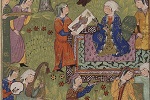
The harps that often appear in Persian paintings bear a striking resemblance tto the West Asian harp deposited in Japan’s Shoso-in repository in the eighth century. The Shoso-in harp served as the model for the instrument used in this concert. In this Persian painting from about 1500, a harpist performs in a scene from the classical love story Khusraw and Shirin by Nizami.
Detail, Shirin Examines Khusraw’s Portrait, folio from a Khamsa (Quintet) by Nizami (d. 1207). Iran, Turkoman period, ca. 1500. Opaque watercolor, ink, color mica, and gold on paper. Purchase–Smithsonian Unrestricted Trust Funds, Smithsonian Collections Acquisition Program, and Dr. Arthur M. Sackler, S1986.140
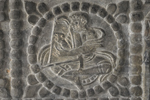
Two hundred years before a West Asian harp was stored in Japan’s Shoso-in repository, this image of a harpist was carved by Sogdians for a funerary couch. The Sogdians, a Persian-speaking people in present-day Uzbekistan or Tajikistan, controlled much of the Silk Road trade from Anatolia to East Asia. This carving once formed part of a sixth-century stone platform that supported the coffin of a dignitary in the Northern Qi dynasty.
Detail, base of a funerary couch. China, Henan province, probably Ce Xian, Northern Qi dynasty, Period of Division, 550–577. Marble with traces of pigment. Gift of Charles Lang Freer, F1915.336

This rare Chinese brocade was also preserved in the Shoso-in. That repository holds many ancient musical instruments from cultures along the Silk Road, including a West Asian harp used as the model for the instrument heard in this concert. Before forming his Silk Road Ensemble, cellist Yo-Yo Ma visited the Shoso-in with Milo Beach, the former director of the Freer and Sackler Galleries.
Detail, textile with floral medallions and lozenges. China, mid-Tang dynasty, first half of 8th century. Brocade (jin): woven silk (weft-faced compound twill). Gift of Charles Lang Freer, F1911.597
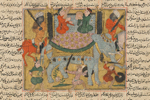
A harpist appears prominently in one of the oldest surviving copies of the Shahnama (Book of Kings), the Persian epic completed by Firdawsi in 1010. Here, a harpist and percussionist perform atop an elephant. They are part of the celebration surrounding the wedding of Zal and Rudaba, parents of the epic hero Rustam. The text claims “elephants and minstrels made Earth a paradise from end to end.”
Detail, Celebrations in Kabulistan, folio from a Shahnama (Book of Kings) by Firdawsi (d. 1020). Probably Iran, Mongol period, early fourteenth century. Opaque watercolor, ink, gold, and silver on paper. Purchase, F1929.34

This fourteenth-century Persian painting shows an ensemble of lute, percussion, harp, and flute performing for a festive enthronement from the Shahnama (Book of Kings), the Persian epic by Firdawsi. The painting appears in a version created for the Inju rulers of Iran (reigned 1325–53).
Detail, double-page frontispiece, from a copy of the Shahnama (Book of Kings) by Firdawsi (d. 1020). Iran, Shiraz, ca. 1352. Opaque watercolor, ink, and gold on paper. Lent by Mr. and Mrs. Farhad Ebrahimi, LTS1998.1.1.2a-b
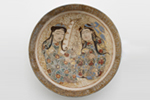
In this ceramic bowl from the late twelfth or early thirteenth century, a woman is entertained by a man playing a harp. Her jeweled headdress suggests she is of high rank. The technique of luster-painted ceramics dates to ninth-century Arab artists in present-day Iraq.
Bowl. Iran, Saljuq period, late 12th–early 13th century. Stone-paste body painted over glaze with enamel (mina'i). Purchase, F1938.12
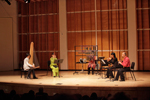
The ensemble for this concert in February 2012 featured performers on several instruments modeled after those preserved in the Shoso-in. Left to right are Fuyuhiko Sasaki, kugo (harp); Mayumi Miyata, sho (mouth organ); Kyoko Kato, chimes; Hitomo Nakamura, hichiriki (double-reed); and Takeshi Sasamoto, Shoso-in shakuhachi.
Listen Now
download
Subscribe (itunes)
Subscribe (rss)
help
The Credits
Podcast recording, notes, and slideshow are coordinated by Michael Wilpers, Manager of Public Programs.
This concert and podcast were made possible through support from the Thaw Charitable Trust. It was presented in conjunction with Silk Road Luxuries from China and as part of the Music From Japan Festival 2012. Audio preservation and editing of this recording were supported by funds from the Smithsonian Women’s Committee.
Thanks to Andy Finch for audio recording, SuMo Productions for audio editing, Nancy Eickel for text editing, Torie Castiello Ketcham for web design, Massumeh Farhad for curatorial review, Betsy Kohut and Cory Grace for artwork images, and especially the artists and Music From Japan for permission to podcast this performance at the Freer Gallery.
Music from Japan
Founded in 1975 by Naoyuki Miura, the group’s current artistic director, Music From Japan is the leading presenter of Japanese contemporary and traditional music in the United States. In tours throughout North and South America, Central Asia, and Japan, the ensemble has presented more than 400 works, including 73 world premieres and 61 commissions, and it has showcased 159 Japanese composers along with traditional Japanese music. Not only has Music From Japan received the Japanese Foreign Minister’s Commendation, but Miura was also awarded the Commissioner of the Agency for Cultural Affairs Award and the Sen Kayoko Award from the Soroptimist Japan Foundation. Music, Journey into the Unknown: Music From Japan Festival — A Chronicle, a book by Kotoko Fukunaka, was published 2011.
Music From Japan’s Festival 2012 was made possible with public funds from the Agency for Cultural Affairs, Government of Japan, for the fiscal year 2011.
Podcast Series
Concerts
Storytelling
Lectures
Subscribe to this Series
 RSS
RSS iTunes
iTunes
About Podcasts
About podcasting and how to get started
![]() Tell us what you think
Tell us what you think
Radio Asia
Explore music from all across Asia with Radio Asia, a stream of complete tracks from the collections of Smithsonian Global Sound
Most Recent Podcasts
Musicians from Marlboro IMusic of Toru Takemitsu and Tan Dun: Ralph Van Raat, piano
The Legacy of Yatsuhashi
The Traveler’s Ear: Scenes from Music
Western Music in Meiji Japan: Gilles Vonsattel, piano
Western Music in Meiji Japan
The Art of Afghan Music
Painting with Music: Bell Yung, qin
Sounds from Arabia
Tarek Yamani Trio